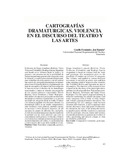| dc.rights.license | http://creativecommons.org/licenses/by-nc-sa/3.0/ve/ | |
| dc.contributor.author | Castillo Fernández, José Ramón | |
| dc.date.accessioned | 2011-08-10T19:09:30Z | |
| dc.date.available | 2011-08-10T19:09:30Z | |
| dc.date.issued | 2010-12-31 | |
| dc.identifier.uri | http://www.saber.ula.ve/handle/123456789/33606 | |
| dc.description.abstract | El discurso de Diego Aramburo (Bolivia), Víctor Viviescas (Colombia) y Rodrigo García (Argentina) está basado en la violencia desde la ironía y lo
grotesco, esta premisa nos da la posibilidad de realizar un panorama general sobre categorías como la violencia, y se aplica al movimiento teatral actual, para vislumbrar un estilo artístico y de allí realizar
una especie de cartografía dramaturgia en algunos países como Colombia, Bolivia y Argentina que son parte de este análisis. El objetivo de la investigación
se basa en revisar el discurso de los dramaturgos mencionados y entrar en sintonía con propuestas de tres artistas plásticos venezolanos: Héctor Baptista, Oscar Abrahams y Ender Rodríguez. Para defi
nir este discurso proyectado en diferentes disciplinas se establece el paralelismo y se procura un estudio de categorías desde la ironía, el humor y la violencia, jugando a los discursos alternos. La
metodología radica en un estudio comparatístico entre literatura y artes plásticas, también consiste en acercarse a otros discursos literarios, de allí encontrar los puntos de infl exión. En conclusión, el
estilo de esta dramaturgia nos deja de manifi esto la paridad con las artes plásticas que está en concordancia con lo grotesco, lo obsceno, el humor y la violencia en constante promoción, para generar un
desbordamiento del orden, el cuestionamiento y crítica incisiva de lo que debe establecer el arte. | es_VE |
| dc.language.iso | es | es_VE |
| dc.publisher | SABER-ULA | es_VE |
| dc.rights | info:eu-repo/semantics/openAccess | |
| dc.subject | Literatura comparada | es_VE |
| dc.subject | Grotesco | es_VE |
| dc.subject | Violencia | es_VE |
| dc.title | Cartografías dramaturgicas. Violencia en el discurso del teatro y las artes plásticas | es_VE |
| dc.title.alternative | Cartographies dramaturgical. Violence in the discourse of the theater and the arts | es_VE |
| dc.type | info:eu-repo/semantics/article | |
| dc.description.abstract1 | Diego Aramburo’s speech (Bolivia), Victor Viviescas (Colombia) and Rodrigo García (Argentina) is based on violence from the irony and grotesque, this assumption gives us the possibility of conduct an
overview of categories like violence, and applied to current theatrical movement, to envision an artistic style and then make mapping a kind of drama in some countries like Colombia, Bolivia and
Argentina are part of this analysis. The objective of the research review is based on the discourse of the playwright above and tune in with proposals three Venezuelan artists: Hector Baptista, Abrahams
and Ender Oscar Rodríguez. For this speech projected defi ning in different establishing the parallel disciplines and seeks categories from a study of irony, humor and violence, playing alternative
discourses. The methodology lies in a analogyc study between literature and visual arts, is also to approach other literary discourses, there fi nd points of infl ection.
In conclusion, the style of this drama that leaves us manifest parity with the visual arts is consistent with the grotesque, obscene, humor and violence
in constant promotion, to generate an overfl ow of order, questioning and incisive critique of what
art should be established. | es_VE |
| dc.description.colacion | 63-73 | es_VE |
| dc.description.email | josecas99@yahoo.es | es_VE |
| dc.publisher.pais | Venezuela | es_VE |
| dc.subject.centroinvestigacion | Centro de Investigaciones Literarias y Lingüísticas Mario Briceño Iragorry | |
| dc.subject.facultad | Núcleo Rafael Rangel (NURR) | es_VE |
| dc.subject.keywords | Comparative literature | es_VE |
| dc.subject.keywords | Grotesque | es_VE |
| dc.subject.keywords | Violence | es_VE |
| dc.subject.publicacionelectronica | Revista Cifra Nueva | |
| dc.subject.seccion | Revista Cifra Nueva: Artículos | es_VE |
| dc.subject.thematiccategory | Artes y Humanidades | es_VE |
| dc.subject.tipo | Revistas | es_VE |
| dc.type.media | Texto | es_VE |


